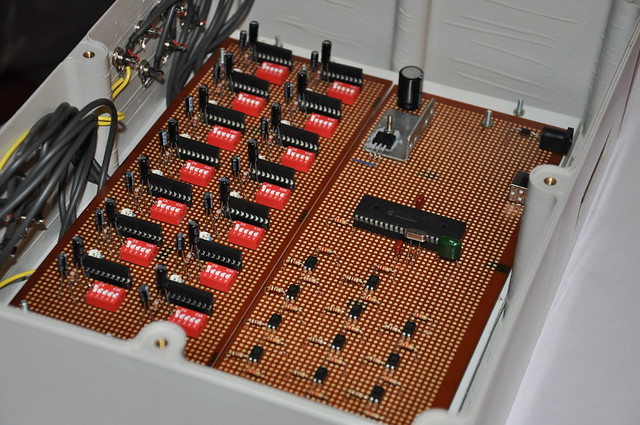CoCA "Emerge + Tech" - Musical plants is an electronics, software and plants base exhibit we developed for Cinnamon Colomboscope 2016 exhibition. This installation will feature a touch-sensitive sensor that will generate a soothing sound from each plant. By interacting with individual plants, the audience can create musical compositions.
The sensor unit of this project consists of 14 high sensitive, configurable level detectors and USB interface. In this sensor unit, we use Samsung's KA2284 as an amplifier, level detector, and PIC18F4550 8-bit MCU as data multiplexer and USB I/O controller. PC817 optoisolators are used to interface between analog front-end and digital data processor. In this design, both analog and digital circuits are physically and electronically isolated to minimize the noises and interferences.
In this design, we use KA2284 because it is commonly available in the local market (in Sri Lanka) and costs less than 0.1 USD. To reduce the interferences we use shielded cables between plants and sensor ICs. With the special wire, we are using we may be able to extend the sensor connectivity up to 3m.
PC application of this project is developed by using HIDAPI and irrKlang libraries. This application is designed to work with Microsoft Windows operating systems and we tested it on Windows 7 and Windows 10.
This project is an open source hardware project released under terms of MIT and CC BY-SA licenses. All the content of this project is available to download at hackaday.io or github.com. Conceptual details of this project are available at CoCA homepage.
The sensor unit of this project consists of 14 high sensitive, configurable level detectors and USB interface. In this sensor unit, we use Samsung's KA2284 as an amplifier, level detector, and PIC18F4550 8-bit MCU as data multiplexer and USB I/O controller. PC817 optoisolators are used to interface between analog front-end and digital data processor. In this design, both analog and digital circuits are physically and electronically isolated to minimize the noises and interferences.
In this design, we use KA2284 because it is commonly available in the local market (in Sri Lanka) and costs less than 0.1 USD. To reduce the interferences we use shielded cables between plants and sensor ICs. With the special wire, we are using we may be able to extend the sensor connectivity up to 3m.
 |
| Sensor board of musical plants project. |
PC application of this project is developed by using HIDAPI and irrKlang libraries. This application is designed to work with Microsoft Windows operating systems and we tested it on Windows 7 and Windows 10.
This project is an open source hardware project released under terms of MIT and CC BY-SA licenses. All the content of this project is available to download at hackaday.io or github.com. Conceptual details of this project are available at CoCA homepage.
Comments